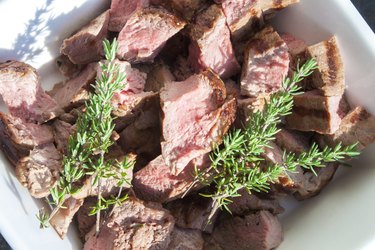
Moose meat isn't something you readily find on most grocery store shelves, but maybe it should be. Not only is the wild game meat high in protein, iron and B vitamins (among other nutrients), it also has a fatty acid profile that's unique to big game species like moose, deer, caribou and elk meat.
If you want to include moose meat in your diet and you're not used to cooking it, there can be a little bit of a learning curve. Like all game meats, it requires a little extra care while cooking, but once you get the hang of it, you may want to make it a staple.
Video of the Day
Video of the Day
Moose Meat Nutrition
The nutritional facts of moose meat are actually quite impressive. It's low in fat, high in protein and loaded with several different types of nutrients. The calories in moose come in at just 113 for a standard 3-ounce serving. The macronutrient breakdown looks like this:
- 25 grams of protein
- 0.8 grams of total fat
- 0 carbohydrates
As for micronutrients (or vitamins and minerals), moose meat contains:
- 3.5 milligrams of iron
- 149 milligrams of phosphorus
- 283 milligrams of potassium
- 197 milligrams of sodium
- 5.3 micrograms of vitamin B12
- 4.5 milligrams of niacin (or vitamin B3)
Read more: How Healthy is Deer Meat?
The Fat in Moose
But it's not just about the nutrients and calories in moose, the wild game meat also has a special fatty acid profile that contributes to some of its health benefits. According to a January 2019 report in Molecules, moose (and caribou) meat are rich in what's classified as "functional fatty acids." These specialized fatty acids have specific, targeted health benefits and a lot of them aren't found in high amounts in other foods.
For example, the report points out that moose is especially high in a type of fatty acids called FAHFAs, or fatty acid esters of hydroxy fatty acids. These fatty acids have been directly linked to improved glucose tolerance and insulin sensitivity in people with diabetes. They've also been shown to stimulate insulin secretion in those who have low levels of insulin. When it comes to FAHFAs, moose and caribou meat nutrition facts were extremely similar.
Moose meat also contains categories of fatty acids called diglycerides and monoacetyldiglycerides, or MAcDG, which isn't typically found in animal meat. Diglycerides help promote healthy fat metabolism and body weight, while MAcDG has been shown to help fight off inflammation and related diseases, which include cancer, autoimmune diseases, asthma and diabetes, according to a January 2018 report in Oncotarget.
Cooking Moose Meat
Because moose meat, and any wild game meat, is leaner than the beef you'll typically get at the local grocery store, some methods of cooking it are better than others. The goal is to use liquid-based cooking methods to add moisture and help the meat retain it's natural juices.
According to the University of Wyoming College of Agriculture and Natural Resources Extension, braising (which involves simmering the moose meat in a little bit of liquid in a covered pot) or basting it with a little fat are the best techniques to improve flavor and produce a more tender end result.
It's also important to avoid overcooking, which can dry out the meat and make it tough, and undercooking, which puts you at risk of food poisoning. It's best to cook game meat at a temperature of no greater than 375 degrees Fahrenheit until it reaches an internal temperature of 165 degrees Fahrenheit.
- Oncotarget: "Inflammatory Responses and Inflammation-Associated Diseases in Organs"
- Molecules: "Moose and Caribou as Novel Sources of Functional Lipids: Fatty Acid Esters of Hydroxy Fatty Acids, Diglycerides and Monoacetyldiglycerides"
- USDA FoodData Central: "Moose, Cooked"
- University of Wyoming College of Agriculture and Natural Resources Extension: "Wild Game"